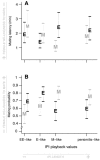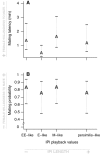Evolution of divergent female mating preference in response to experimental sexual selection
- PMID: 24931497
- PMCID: PMC4262321
- DOI: 10.1111/evo.12473
Evolution of divergent female mating preference in response to experimental sexual selection
Abstract
Sexual selection is predicted to drive the coevolution of mating signals and preferences (mating traits) within populations, and could play a role in speciation if sexual isolation arises due to mating trait divergence between populations. However, few studies have demonstrated that differences in mating traits between populations result from sexual selection alone. Experimental evolution is a promising approach to directly examine the action of sexual selection on mating trait divergence among populations. We manipulated the opportunity for sexual selection (low vs. high) in populations of Drosophila pseudoobscura. Previous studies on these experimental populations have shown that sexual selection manipulation resulted in the divergence between sexual selection treatments of several courtship song parameters, including interpulse interval (IPI) which markedly influences male mating success. Here, we measure female preference for IPI using a playback design to test for preference divergence between the sexual selection treatments after 130 generations of experimental sexual selection. The results suggest that female preference has coevolved with male signal, in opposite directions between the sexual selection treatments, providing direct evidence of the ability of sexual selection to drive the divergent coevolution of mating traits between populations. We discuss the implications in the context sexual selection and speciation.
Keywords: Coevolution; Drosophila; courtship song; experimental evolution; population divergence; speciation.
© 2014 The Authors. Evolution published by Wiley Periodicals, Inc. on behalf of The Society for the Study of Evolution.
Figures



Similar articles
-
Divergence of a speciation trait through artificial selection: Insights into constraints, by-product effects and sexual isolation.J Evol Biol. 2023 Feb;36(2):355-367. doi: 10.1111/jeb.14146. Epub 2022 Dec 28. J Evol Biol. 2023. PMID: 36576691
-
Experimental manipulation of sexual selection and the evolution of courtship song in Drosophila pseudoobscura.Behav Genet. 2005 May;35(3):245-55. doi: 10.1007/s10519-005-3217-0. Behav Genet. 2005. PMID: 15864440
-
The search for causal traits of speciation: Divergent female mate preferences target male courtship song, not pheromones, in Drosophila athabasca species complex.Evolution. 2016 Mar;70(3):526-42. doi: 10.1111/evo.12870. Epub 2016 Mar 3. Evolution. 2016. PMID: 26831347
-
Role of sexual selection in speciation in Drosophila.Genetica. 2014 Feb;142(1):23-41. doi: 10.1007/s10709-013-9751-4. Epub 2013 Dec 22. Genetica. 2014. PMID: 24362558 Review.
-
Speciation by sexual selection: 20 years of progress.Trends Ecol Evol. 2021 Dec;36(12):1153-1163. doi: 10.1016/j.tree.2021.09.004. Epub 2021 Oct 1. Trends Ecol Evol. 2021. PMID: 34607719 Review.
Cited by
-
Experimental evolution supports signatures of sexual selection in genomic divergence.Evol Lett. 2021 Mar 22;5(3):214-229. doi: 10.1002/evl3.220. eCollection 2021 Jun. Evol Lett. 2021. PMID: 34136270 Free PMC article.
-
Asymmetric reinforcement in Lucania killifish: assessing reproductive isolation when both sexes choose.Curr Zool. 2021 Apr;67(2):215-224. doi: 10.1093/cz/zoaa049. Epub 2020 Nov 30. Curr Zool. 2021. PMID: 33854539 Free PMC article.
-
A history of studies of reproductive isolation between Drosophila pseudoobscura and D. persimilis.Fly (Austin). 2025 Dec;19(1):2439111. doi: 10.1080/19336934.2024.2439111. Epub 2024 Dec 20. Fly (Austin). 2025. PMID: 39707709 Free PMC article. Review.
-
Rapid evolution of the intersexual genetic correlation for fitness in Drosophila melanogaster.Evolution. 2016 Apr;70(4):781-95. doi: 10.1111/evo.12892. Epub 2016 Mar 17. Evolution. 2016. PMID: 27077679 Free PMC article.
-
Selection on the Fly: Short-Term Adaptation to an Altered Sexual Selection Regime in Drosophila pseudoobscura.Genome Biol Evol. 2023 Jul 3;15(7):evad113. doi: 10.1093/gbe/evad113. Genome Biol Evol. 2023. PMID: 37341535 Free PMC article.
References
-
- Anderson W. Frequent multiple insemination in a natural population of Drosophila pseudoobscura. Am. Nat. 1974;108:709–711.
-
- Andersson MB. Sexual selection. Trends Ecol. Evol. 1996;11:53–58. - PubMed
-
- Arnqvist G. Spatial variation in selective regimes: sexual selection in the water strider, Gerris odontogaster. Evolution. 1992;46:914–929. - PubMed
-
- Bacigalupe LD, Crudgington HS, Hunter F, Moore AJ. Snook RR. Sexual conflict does not drive reproductive isolation in experimental populations of Drosophila pseudoobscura. J. Evol. Biol. 2007;20:1763–1771. - PubMed
-
- Bacigalupe LD, Crudgington HS, Slate J, Moore AJ. Snook RR. Sexual selection and interacting phenotypes in experimental evolution: a study of Drosophila pseudoobscura mating behavior. Evolution. 2008;62:1804–1812. - PubMed
Publication types
MeSH terms
Associated data
LinkOut - more resources
Full Text Sources
Other Literature Sources
Molecular Biology Databases
